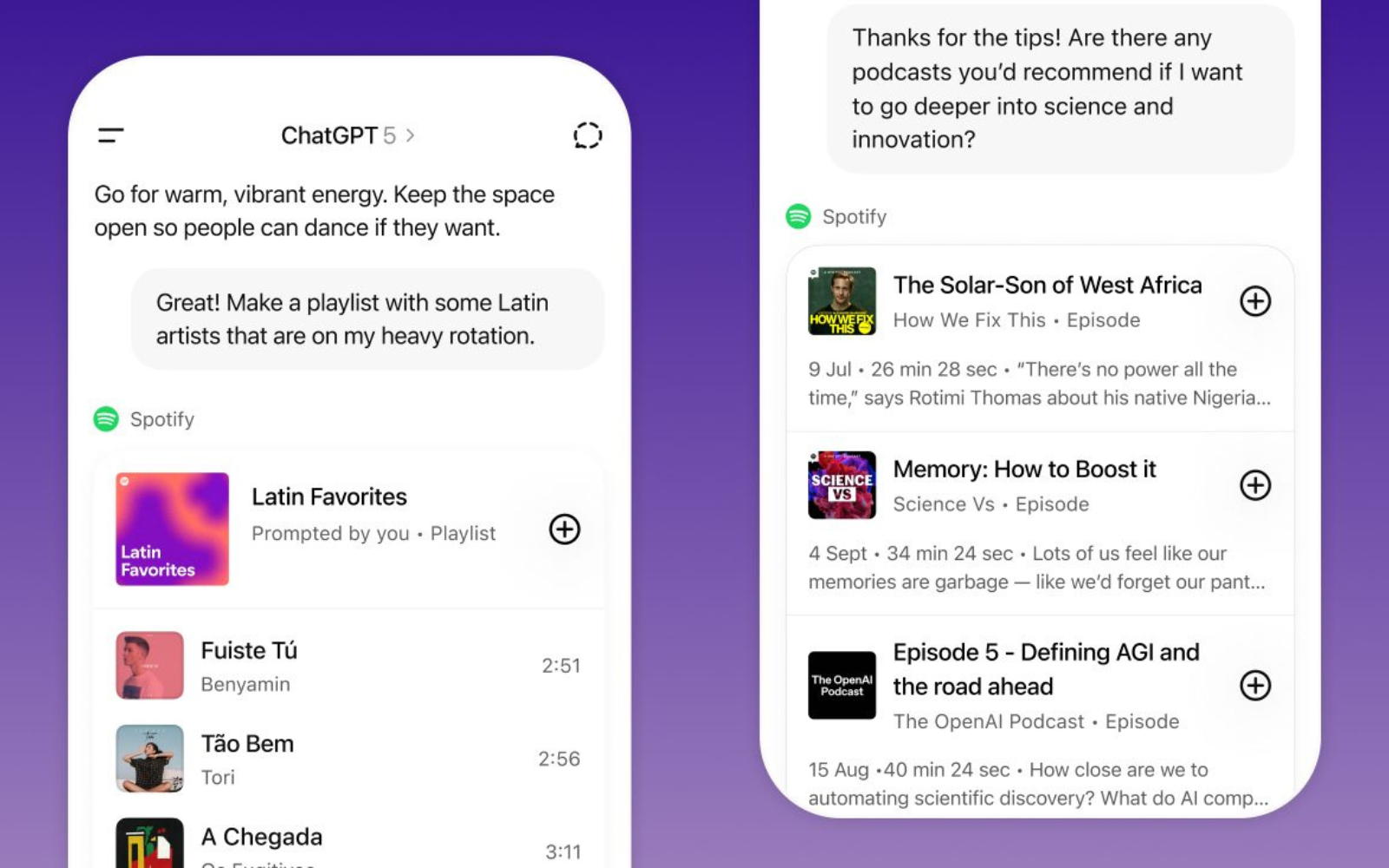Introducing ChatGPT & Spotify Integration
Yesterday Spotify launched a new integration: users can now bring their Spotify accounts into ChatGPT conversations. This means that whether you're planning a concert, creating prompts for creative projects, or just chatting about your favorite genres, you can ask ChatGPT to pull up personalized recommendations, playlists, podcast episodes, and more—right in the flow of your conversation. You will need to connect your Spotify account to your ChatGPT account to make this work. All you need to do is mention Spotify in your prompt and you should see the workflow appear. What’s very cool about this new integration is that both free and Premium users can take advantage of this; while free users may draw from existing playlists (like Discover Weekly or New Music Friday), Premium users can generate more bespoke, personalized picks informed by their listening habits. Spotify makes clear that the connection is opt-in and that user privacy is retained: Spotify will not share its audio content with OpenAI for training purposes.
Whenever I see things like this appear in my news feed, my first thought is always centered on How can music teachers use this? As a music educator this news raises possibilities and questions for how we support student listening, musical discovery, and creative inquiry in the classroom. Of course, there are some caveats: the quality of recommendations depends on the richness of Spotify’s personalization algorithms (and those evolve). Teachers without Spotify Premium may have some constraints. And, as always, we need to be aware of biases—what music tends to be surfaced (popular, Western, mainstream) versus what is marginalized or underrepresented.
Still: as a music educator, I see this as a new tool in our listening-and-creation toolkit. And yes—we must teach students how to use it thoughtfully, not blindly. What follows are some categorized prompt ideas that I think music teachers can use, with a link to the results that I got using my own personal Spotify Premium Account:
Active Listening & Analysis
Create a playlist of 5 pieces that use syncopation in creative ways. Describe how rhythm changes the listener’s sense of groove.
Find 6 songs in different genres that feature strong use of ostinato. Note how each artist layers or varies it.
Generate a playlist of 8 tracks that use call-and-response between instruments or voices.
Give me 7 songs that modulate to a new key halfway through.
Can you suggest 10 upbeat songs that are at 128bpm?
Teachers can adapt or scaffold these: for beginners, simplify to “3 songs” or fewer, or provide a list of adjectives students may use in prompts (“soaring, introspective, rhythmic, sparse, lush”). You can also specify the genre of music you’d like to include and/or exclude from your playlist. Over time you can evolve their prompt-making, bringing more nuance to the resulting playlists.
Here are some more prompts that I’ve come up with along with some ideas for student responses, but here I’ll leave out the embedded results:
Creativity
Generate a 5-song playlist that captures the feeling of sunrise. After listening, have the students compose a short melody inspired by it.
Can you please list 5 EDM songs that have a tempo of 130bpm? Use the results to create your own mashup.
Create a playlist that blends electronic and acoustic textures. Use one track as inspiration for a short loop or beat.
Find 4 jazz standards reinterpreted in modern styles (lo-fi, funk, pop). What’s kept from the original, and what’s reinvented? Can you create your own version?
List 6 songs that tell a story without lyrics. Write a short narrative describing the plot you imagine.
Make a playlist that alternates major and minor moods. Compose or improvise your own piece following that emotional and harmonic structure
Cultural & Historical Context
Find 5 songs that influenced early hip-hop. For each, identify the rhythmic or lyrical ideas sampled or borrowed later.
Generate 6 examples of protest songs from different decades. Discuss how musical style and message evolve over time.
Ask for a playlist of 5 contemporary global artists using traditional instruments in new ways.
Create a list of songs that defined each decade from the 1950s to the 2020s.
Find 4 versions of the same folk song recorded by different artists and in differents eras. Compare tempo, instrumentation, and mood.
Listening
Generate a playlist with 5 songs that express hope. Which musical features make them feel optimistic to you?
Find 5 tracks that match your current mood. After listening, explain why the harmony, tempo, or lyrics resonate with that way you are feeling.
Generate a playlist for ‘study focus’ and one for ‘performance hype.’ Discuss why different tempos and textures fit each goal.
Ask for songs that remind you of your childhood or family culture. Share your playlist with the class and explain its meaning.
Find 6 songs where the lyrics and music tell different emotional stories — for example, happy music with sad lyrics. Why does it work?
I often remind teachers that innovation in music education isn’t about bringing new tech into the room for the sake of doing so, but helping students become more intentional, curious, and reflective and hopefully lifelong music makers. The Spotify + ChatGPT integration is another tool for music teachers to explore. I personally think it makes our jobs easier - especially when you need to find musical examples to illustrate concepts that you are teaching. If you’re a Spotify user and you also dabble with ChatGPT, I highly recommend checking this out. I’ve already been down a rabbit hole for a few hours this morning, and I’m pretty sure you will be too.
